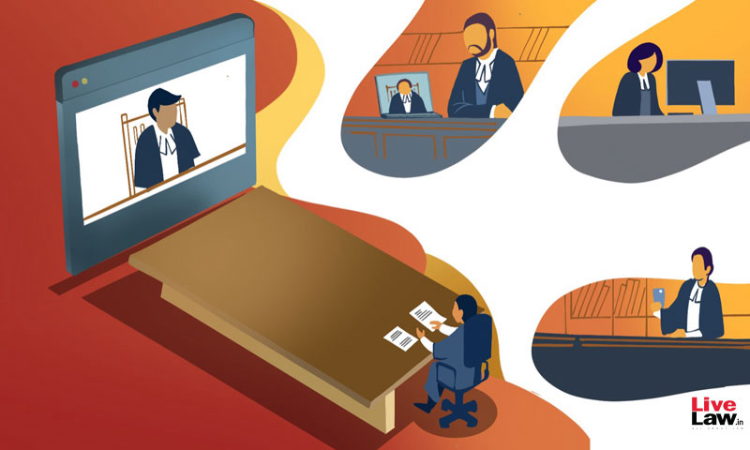Technological Glitches At Trial Courts Plaguing Virtual Hearings
Karan Tripathi
14 Aug 2020 8:30 AM IST

A man disturbed by the prolonged delay in his divorce proceedings due to the suspended functioning of the family courts, approached the Delhi High Court seeking relief. 'Family Courts must be directed to record evidence through video-conferencing', he argued. Just a couple of hearings later, the Division Bench of the court realised that there is a larger issue concerning the virtual functioning of the trial courts during the pandemic - internet.
In Anand Vaid v. Preeti Vaid, the rabbit came out of the hat and the court was suddenly made aware of the technological concerns that plague the trial courts in Delhi. It appeared that proposals for providing basic digitisation facilities to the district courts in Delhi - digitisation of records, adequate internet bandwidth, etc. - have been pending for 2 years. Entangled between layers of red-tapism and administrative delays, the quantum reality of sluggish digitisation of district courts manifested itself only during the second installment of the lockdown imposed in light of a global pandemic.
However, the problem is far from over; the concerns have just begun to surface. Advocates have started to complain about the conducting of virtual hearings at district courts; they are often not as seamless as they ought to be.
Senior Advocate Mohit Mathur, for instance, complained about the lack of adequate bandwidth affecting the process of holding virtual hearings. He said that due to the poor bandwidth, district courts are forced to use the free version of CISCO Webex app which only provides 40 minutes for each hearing. After the 40 minutes are over, Mr Mathur said, hearings are automatically disconnected and one has to go through the entire process of establishing a connection again.
'Halfway through the arguments, the advocates are automatically delinked', Mr Mathur said.
In fact, Delhi High Court Bar Association through its Secretary Mr Abhijat also raised concerns regarding the unflattering quality of virtual hearings before the district courts.
Mr Shreesh Chadha, an advocate practicing in Delhi and Gurgaon, informed us that the bandwidth available at Karkardooma District Court is so bad that often he's forced to type out his arguments in the chat box.
There's also an issue with proper case management. As Mr Bilal, another Advocate practicing in Delhi, pointed out, advocates are often pulled up by the judges for joining the hearing link prior to the commencement of their matters. 'When judges are informed that the concerned advocate has joined the hearing at a conference time allocated to him by the court itself, the concerned judge either abruptly stops the ongoing hearing to take up his matter, or asks him to wait till the end of the board', Mr Bilal said.
As it was pointed out before the Division Bench of Justice Hima Kohli and Justice Subramonium Prasad at the Delhi High Court, the poor quality of virtual hearings has much to do with the budgetary issues and proposals for digitisation which are still stuck in the pipeline. The court was informed that despite the communications being made by the District & Sessions Courts (Headquarters) time and again, the Delhi Government has not approved the said proposals since 2018.
These proposals pertain to digitisation of the trial court records, providing sufficient and updated computer hardware and software, and upgrading the bandwidth provided to the district courts.
'Lawyers, litigants and subordinate judiciary are being inconvenienced due to the lack of digitisation of the district courts', the said Bench noted.
The Delhi High Court has provided an elaborate and quite exhaustive procedure for recording evidence and conducting trials through video conferencing. These Rules provide for setting up of requisite infrastructure, appointment of concerned officers, and taking recourse to technological tools for making real time operation of virtual hearings possible and hassle free from multiple remote points.
However, the implementation of the said Rules are not in sight as of now. The Delhi Government has also sought time from the court for taking some action on its pending promises of digitisation. The concern, though, is not just restricted to making virtual hearings at trial courts seamless; it also pertains to equally, if not more, significant concern of public access to criminal trials.
Any mechanism put forward for making subordinate judiciary more updated with technological advancements must also address the issue of transparency and accountability - the issue of media and public access to trials. Especially when many high profile and sensitive cases such as Delhi Riots, Jamia Violence, etc. are all geared up to move closer towards the stage of trial, cases where the very nature of adjudication becomes a matter of public interest, the issue of public access cannot be compromised.
Any such mechanism must also ensure that not just there's a route for public participation, but that such a route is legitimate and made equally accessible to all. Public and media participation in trials conducted through virtual hearings cannot be made selective and amenable to subjective discretion of the court officials. The policy has to clearly chalk out objective reasons on the basis of which such access can be denied by the officers and also an obligation on such officers to justify as to why excluding public access, or allowing selective access, serves as a reasonable restriction to one's right to participate in what are supposed to be open court hearings.
The road ahead for virtual hearings at subordinate courts involve settling standing issues and creating a robust mechanism for a structural change in judiciary. Neglecting the concerns of subordinate judiciary will only make it more difficult for such changes to be effectively implemented at the level of the High Courts and the Supreme Court.


